Law and Ethics in Healthcare: A Case Study on DNR Directive
VerifiedAdded on 2021/06/17
|10
|2861
|44
Essay
AI Summary
This essay delves into the complex interplay of law and ethics in healthcare, specifically focusing on Do Not Resuscitate (DNR) directives. It examines the legal framework surrounding advanced care directives, consent, and the responsibilities of healthcare providers. The essay explores the ethical principles of autonomy, beneficence, non-maleficence, and justice within the context of patient care, using a case study involving a patient with a DNR directive and her family's conflicting opinions. The analysis considers the importance of informed consent, the role of family members in decision-making when the patient is incapacitated, and the potential legal and ethical implications of medical interventions. The essay emphasizes the importance of balancing patient wishes, legal requirements, and ethical considerations to ensure the best possible care and uphold patient rights.
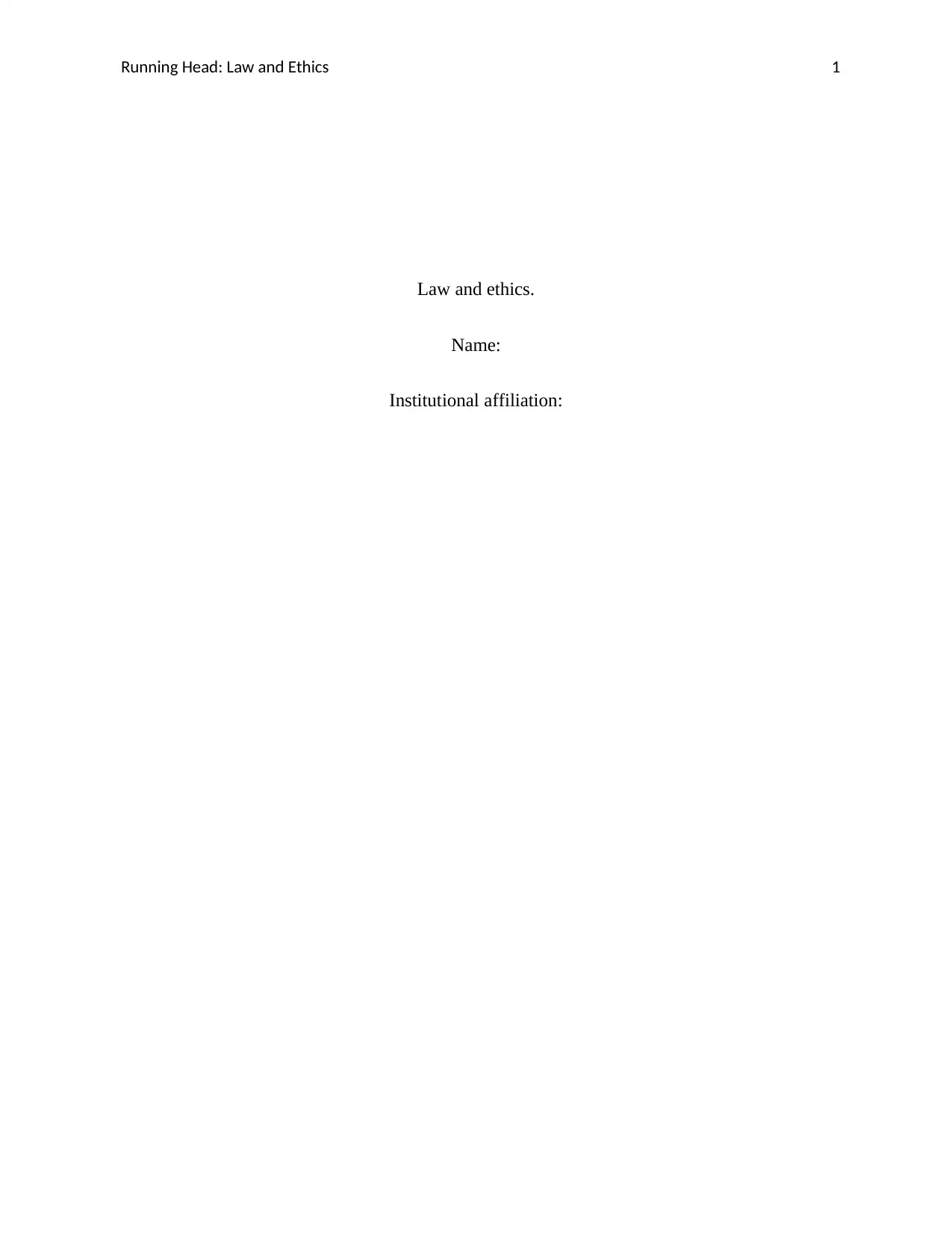
Running Head: Law and Ethics 1
Law and ethics.
Name:
Institutional affiliation:
Law and ethics.
Name:
Institutional affiliation:
Paraphrase This Document
Need a fresh take? Get an instant paraphrase of this document with our AI Paraphraser
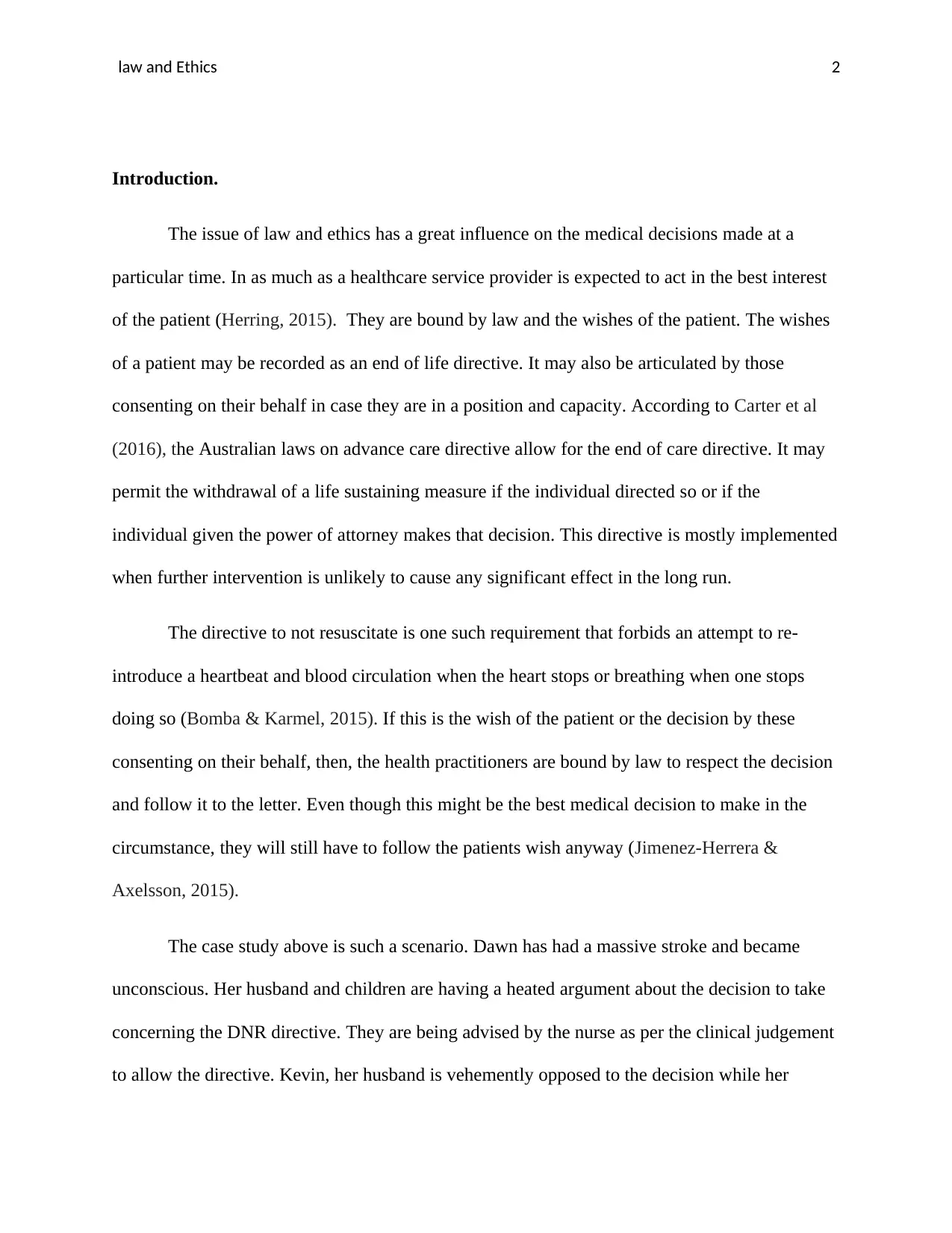
law and Ethics 2
Introduction.
The issue of law and ethics has a great influence on the medical decisions made at a
particular time. In as much as a healthcare service provider is expected to act in the best interest
of the patient (Herring, 2015). They are bound by law and the wishes of the patient. The wishes
of a patient may be recorded as an end of life directive. It may also be articulated by those
consenting on their behalf in case they are in a position and capacity. According to Carter et al
(2016), the Australian laws on advance care directive allow for the end of care directive. It may
permit the withdrawal of a life sustaining measure if the individual directed so or if the
individual given the power of attorney makes that decision. This directive is mostly implemented
when further intervention is unlikely to cause any significant effect in the long run.
The directive to not resuscitate is one such requirement that forbids an attempt to re-
introduce a heartbeat and blood circulation when the heart stops or breathing when one stops
doing so (Bomba & Karmel, 2015). If this is the wish of the patient or the decision by these
consenting on their behalf, then, the health practitioners are bound by law to respect the decision
and follow it to the letter. Even though this might be the best medical decision to make in the
circumstance, they will still have to follow the patients wish anyway (Jimenez-Herrera &
Axelsson, 2015).
The case study above is such a scenario. Dawn has had a massive stroke and became
unconscious. Her husband and children are having a heated argument about the decision to take
concerning the DNR directive. They are being advised by the nurse as per the clinical judgement
to allow the directive. Kevin, her husband is vehemently opposed to the decision while her
Introduction.
The issue of law and ethics has a great influence on the medical decisions made at a
particular time. In as much as a healthcare service provider is expected to act in the best interest
of the patient (Herring, 2015). They are bound by law and the wishes of the patient. The wishes
of a patient may be recorded as an end of life directive. It may also be articulated by those
consenting on their behalf in case they are in a position and capacity. According to Carter et al
(2016), the Australian laws on advance care directive allow for the end of care directive. It may
permit the withdrawal of a life sustaining measure if the individual directed so or if the
individual given the power of attorney makes that decision. This directive is mostly implemented
when further intervention is unlikely to cause any significant effect in the long run.
The directive to not resuscitate is one such requirement that forbids an attempt to re-
introduce a heartbeat and blood circulation when the heart stops or breathing when one stops
doing so (Bomba & Karmel, 2015). If this is the wish of the patient or the decision by these
consenting on their behalf, then, the health practitioners are bound by law to respect the decision
and follow it to the letter. Even though this might be the best medical decision to make in the
circumstance, they will still have to follow the patients wish anyway (Jimenez-Herrera &
Axelsson, 2015).
The case study above is such a scenario. Dawn has had a massive stroke and became
unconscious. Her husband and children are having a heated argument about the decision to take
concerning the DNR directive. They are being advised by the nurse as per the clinical judgement
to allow the directive. Kevin, her husband is vehemently opposed to the decision while her
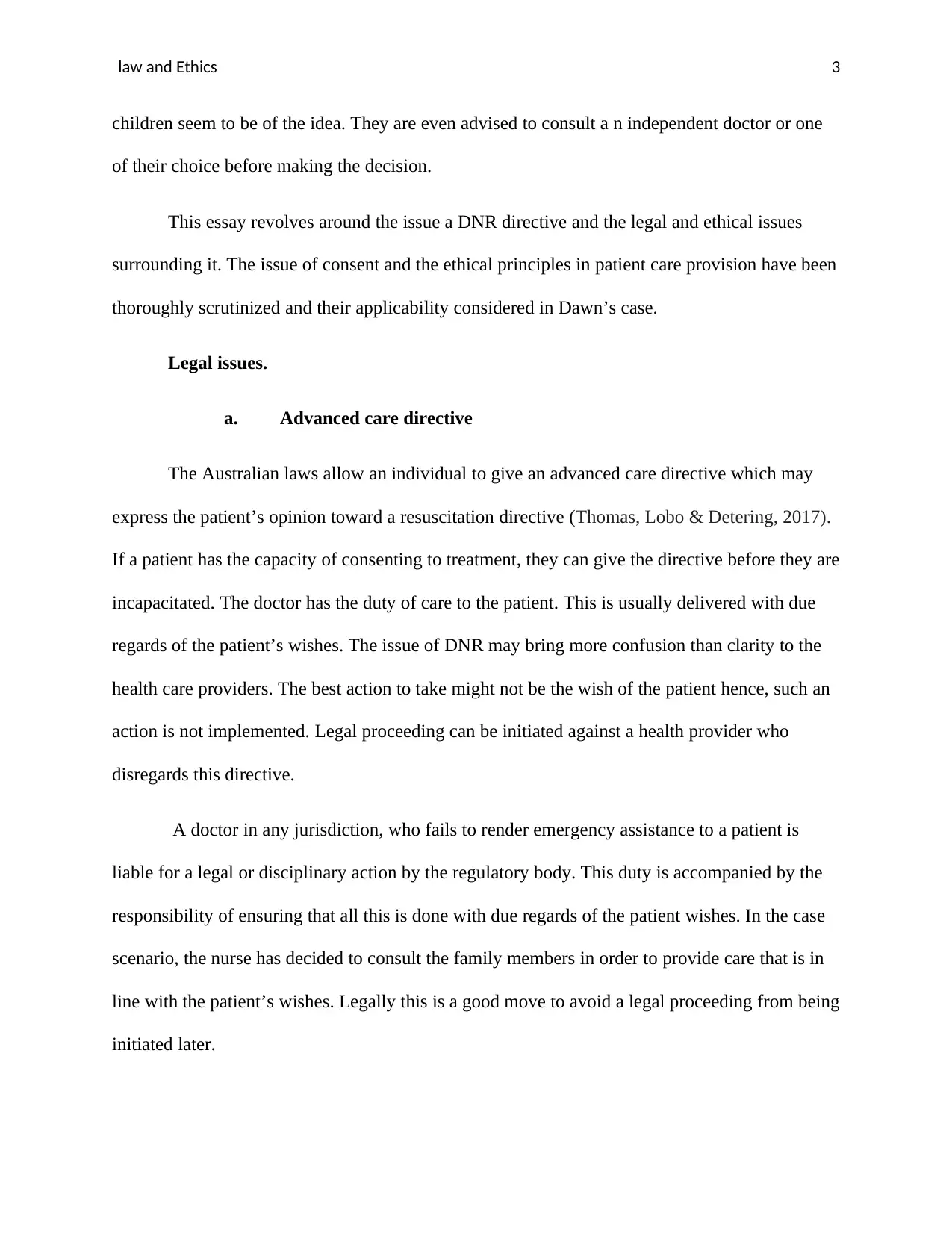
law and Ethics 3
children seem to be of the idea. They are even advised to consult a n independent doctor or one
of their choice before making the decision.
This essay revolves around the issue a DNR directive and the legal and ethical issues
surrounding it. The issue of consent and the ethical principles in patient care provision have been
thoroughly scrutinized and their applicability considered in Dawn’s case.
Legal issues.
a. Advanced care directive
The Australian laws allow an individual to give an advanced care directive which may
express the patient’s opinion toward a resuscitation directive (Thomas, Lobo & Detering, 2017).
If a patient has the capacity of consenting to treatment, they can give the directive before they are
incapacitated. The doctor has the duty of care to the patient. This is usually delivered with due
regards of the patient’s wishes. The issue of DNR may bring more confusion than clarity to the
health care providers. The best action to take might not be the wish of the patient hence, such an
action is not implemented. Legal proceeding can be initiated against a health provider who
disregards this directive.
A doctor in any jurisdiction, who fails to render emergency assistance to a patient is
liable for a legal or disciplinary action by the regulatory body. This duty is accompanied by the
responsibility of ensuring that all this is done with due regards of the patient wishes. In the case
scenario, the nurse has decided to consult the family members in order to provide care that is in
line with the patient’s wishes. Legally this is a good move to avoid a legal proceeding from being
initiated later.
children seem to be of the idea. They are even advised to consult a n independent doctor or one
of their choice before making the decision.
This essay revolves around the issue a DNR directive and the legal and ethical issues
surrounding it. The issue of consent and the ethical principles in patient care provision have been
thoroughly scrutinized and their applicability considered in Dawn’s case.
Legal issues.
a. Advanced care directive
The Australian laws allow an individual to give an advanced care directive which may
express the patient’s opinion toward a resuscitation directive (Thomas, Lobo & Detering, 2017).
If a patient has the capacity of consenting to treatment, they can give the directive before they are
incapacitated. The doctor has the duty of care to the patient. This is usually delivered with due
regards of the patient’s wishes. The issue of DNR may bring more confusion than clarity to the
health care providers. The best action to take might not be the wish of the patient hence, such an
action is not implemented. Legal proceeding can be initiated against a health provider who
disregards this directive.
A doctor in any jurisdiction, who fails to render emergency assistance to a patient is
liable for a legal or disciplinary action by the regulatory body. This duty is accompanied by the
responsibility of ensuring that all this is done with due regards of the patient wishes. In the case
scenario, the nurse has decided to consult the family members in order to provide care that is in
line with the patient’s wishes. Legally this is a good move to avoid a legal proceeding from being
initiated later.
⊘ This is a preview!⊘
Do you want full access?
Subscribe today to unlock all pages.

Trusted by 1+ million students worldwide
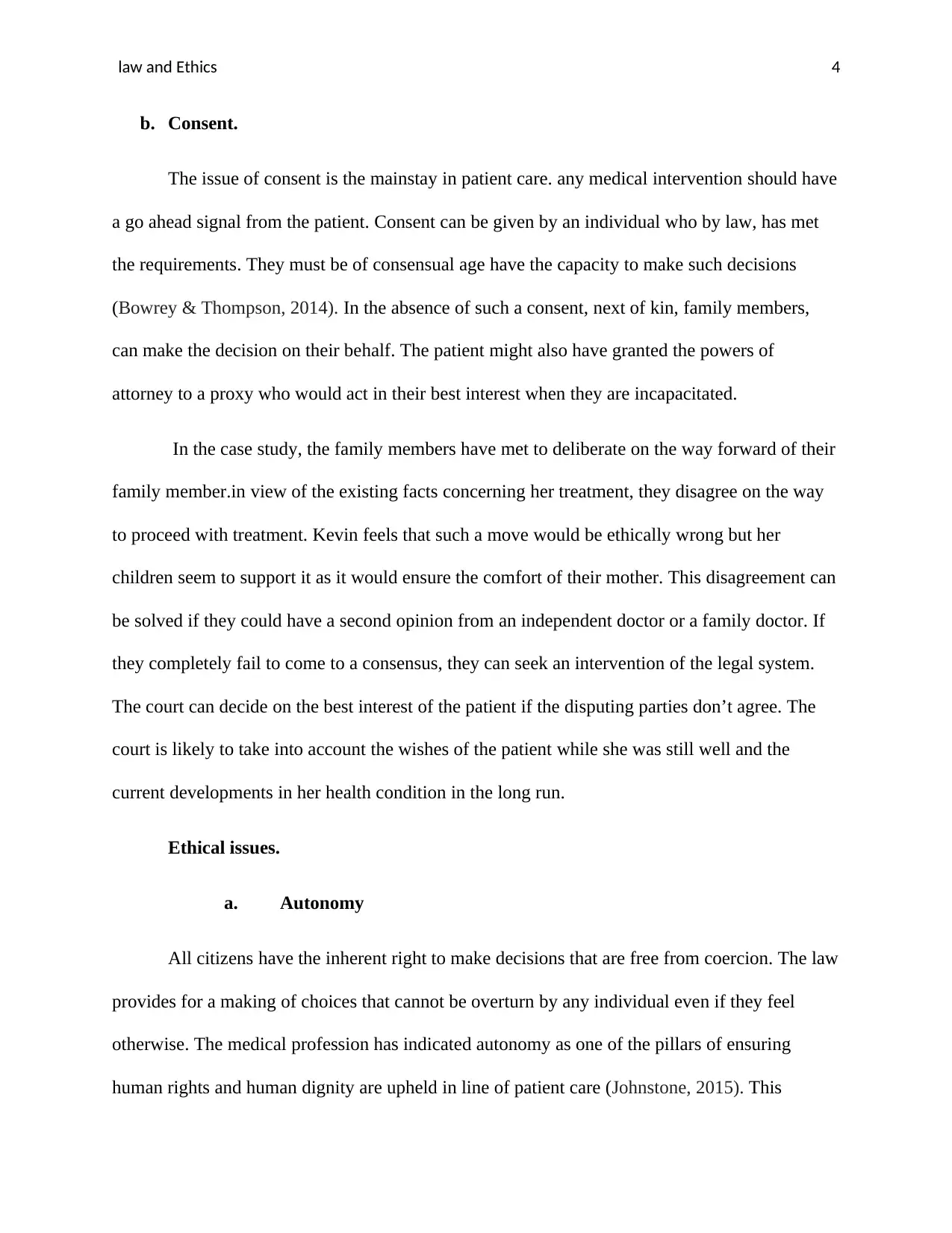
law and Ethics 4
b. Consent.
The issue of consent is the mainstay in patient care. any medical intervention should have
a go ahead signal from the patient. Consent can be given by an individual who by law, has met
the requirements. They must be of consensual age have the capacity to make such decisions
(Bowrey & Thompson, 2014). In the absence of such a consent, next of kin, family members,
can make the decision on their behalf. The patient might also have granted the powers of
attorney to a proxy who would act in their best interest when they are incapacitated.
In the case study, the family members have met to deliberate on the way forward of their
family member.in view of the existing facts concerning her treatment, they disagree on the way
to proceed with treatment. Kevin feels that such a move would be ethically wrong but her
children seem to support it as it would ensure the comfort of their mother. This disagreement can
be solved if they could have a second opinion from an independent doctor or a family doctor. If
they completely fail to come to a consensus, they can seek an intervention of the legal system.
The court can decide on the best interest of the patient if the disputing parties don’t agree. The
court is likely to take into account the wishes of the patient while she was still well and the
current developments in her health condition in the long run.
Ethical issues.
a. Autonomy
All citizens have the inherent right to make decisions that are free from coercion. The law
provides for a making of choices that cannot be overturn by any individual even if they feel
otherwise. The medical profession has indicated autonomy as one of the pillars of ensuring
human rights and human dignity are upheld in line of patient care (Johnstone, 2015). This
b. Consent.
The issue of consent is the mainstay in patient care. any medical intervention should have
a go ahead signal from the patient. Consent can be given by an individual who by law, has met
the requirements. They must be of consensual age have the capacity to make such decisions
(Bowrey & Thompson, 2014). In the absence of such a consent, next of kin, family members,
can make the decision on their behalf. The patient might also have granted the powers of
attorney to a proxy who would act in their best interest when they are incapacitated.
In the case study, the family members have met to deliberate on the way forward of their
family member.in view of the existing facts concerning her treatment, they disagree on the way
to proceed with treatment. Kevin feels that such a move would be ethically wrong but her
children seem to support it as it would ensure the comfort of their mother. This disagreement can
be solved if they could have a second opinion from an independent doctor or a family doctor. If
they completely fail to come to a consensus, they can seek an intervention of the legal system.
The court can decide on the best interest of the patient if the disputing parties don’t agree. The
court is likely to take into account the wishes of the patient while she was still well and the
current developments in her health condition in the long run.
Ethical issues.
a. Autonomy
All citizens have the inherent right to make decisions that are free from coercion. The law
provides for a making of choices that cannot be overturn by any individual even if they feel
otherwise. The medical profession has indicated autonomy as one of the pillars of ensuring
human rights and human dignity are upheld in line of patient care (Johnstone, 2015). This
Paraphrase This Document
Need a fresh take? Get an instant paraphrase of this document with our AI Paraphraser
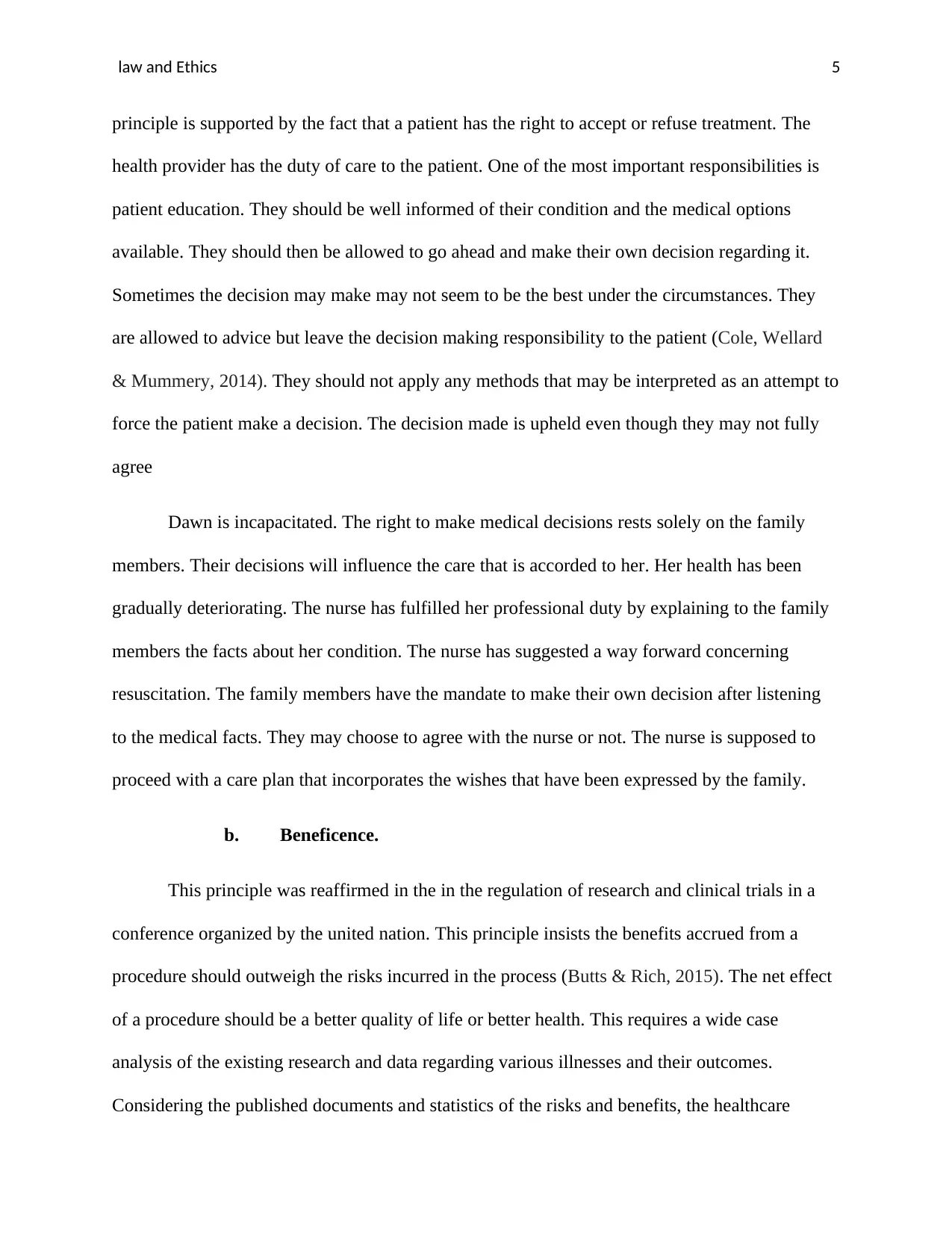
law and Ethics 5
principle is supported by the fact that a patient has the right to accept or refuse treatment. The
health provider has the duty of care to the patient. One of the most important responsibilities is
patient education. They should be well informed of their condition and the medical options
available. They should then be allowed to go ahead and make their own decision regarding it.
Sometimes the decision may make may not seem to be the best under the circumstances. They
are allowed to advice but leave the decision making responsibility to the patient (Cole, Wellard
& Mummery, 2014). They should not apply any methods that may be interpreted as an attempt to
force the patient make a decision. The decision made is upheld even though they may not fully
agree
Dawn is incapacitated. The right to make medical decisions rests solely on the family
members. Their decisions will influence the care that is accorded to her. Her health has been
gradually deteriorating. The nurse has fulfilled her professional duty by explaining to the family
members the facts about her condition. The nurse has suggested a way forward concerning
resuscitation. The family members have the mandate to make their own decision after listening
to the medical facts. They may choose to agree with the nurse or not. The nurse is supposed to
proceed with a care plan that incorporates the wishes that have been expressed by the family.
b. Beneficence.
This principle was reaffirmed in the in the regulation of research and clinical trials in a
conference organized by the united nation. This principle insists the benefits accrued from a
procedure should outweigh the risks incurred in the process (Butts & Rich, 2015). The net effect
of a procedure should be a better quality of life or better health. This requires a wide case
analysis of the existing research and data regarding various illnesses and their outcomes.
Considering the published documents and statistics of the risks and benefits, the healthcare
principle is supported by the fact that a patient has the right to accept or refuse treatment. The
health provider has the duty of care to the patient. One of the most important responsibilities is
patient education. They should be well informed of their condition and the medical options
available. They should then be allowed to go ahead and make their own decision regarding it.
Sometimes the decision may make may not seem to be the best under the circumstances. They
are allowed to advice but leave the decision making responsibility to the patient (Cole, Wellard
& Mummery, 2014). They should not apply any methods that may be interpreted as an attempt to
force the patient make a decision. The decision made is upheld even though they may not fully
agree
Dawn is incapacitated. The right to make medical decisions rests solely on the family
members. Their decisions will influence the care that is accorded to her. Her health has been
gradually deteriorating. The nurse has fulfilled her professional duty by explaining to the family
members the facts about her condition. The nurse has suggested a way forward concerning
resuscitation. The family members have the mandate to make their own decision after listening
to the medical facts. They may choose to agree with the nurse or not. The nurse is supposed to
proceed with a care plan that incorporates the wishes that have been expressed by the family.
b. Beneficence.
This principle was reaffirmed in the in the regulation of research and clinical trials in a
conference organized by the united nation. This principle insists the benefits accrued from a
procedure should outweigh the risks incurred in the process (Butts & Rich, 2015). The net effect
of a procedure should be a better quality of life or better health. This requires a wide case
analysis of the existing research and data regarding various illnesses and their outcomes.
Considering the published documents and statistics of the risks and benefits, the healthcare
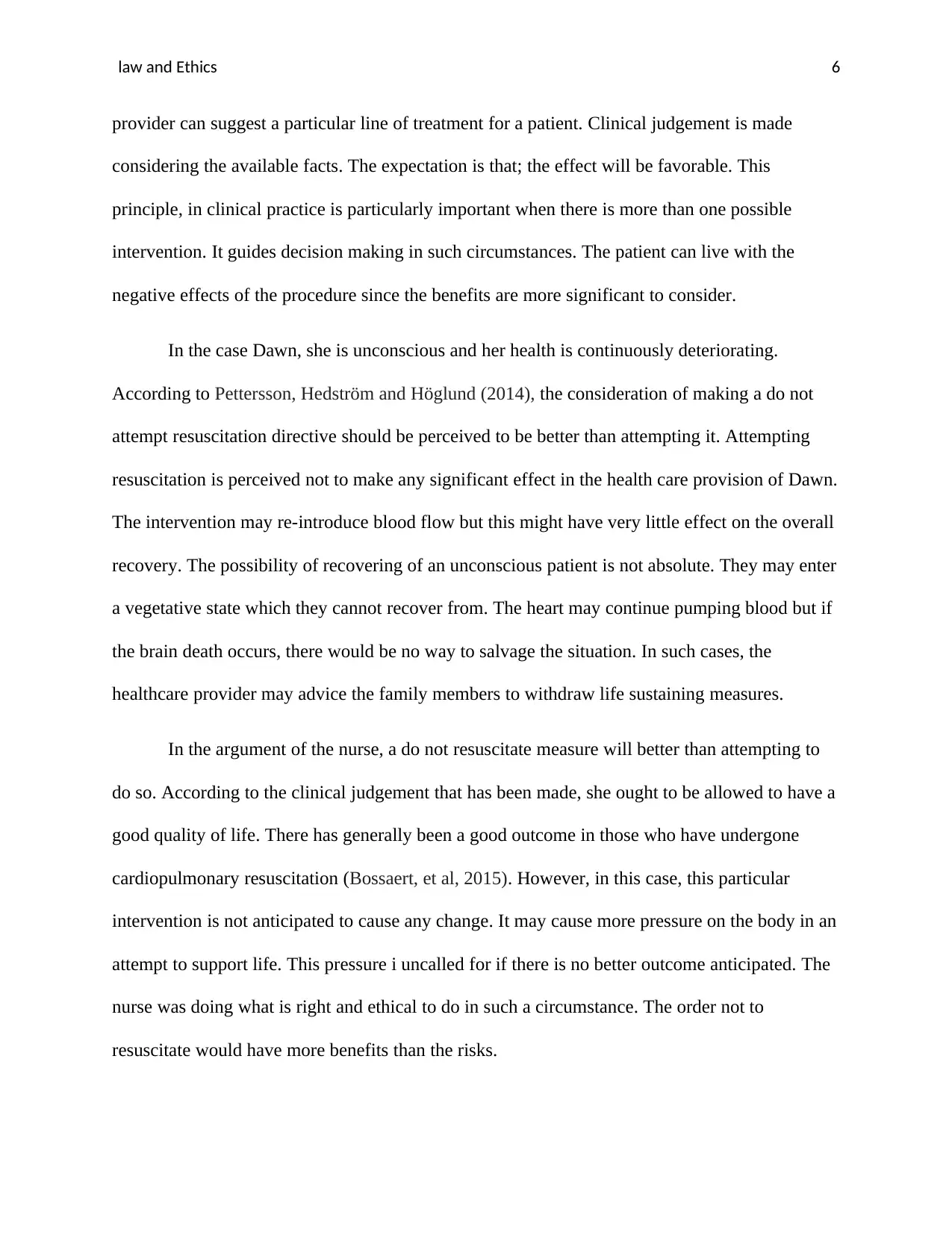
law and Ethics 6
provider can suggest a particular line of treatment for a patient. Clinical judgement is made
considering the available facts. The expectation is that; the effect will be favorable. This
principle, in clinical practice is particularly important when there is more than one possible
intervention. It guides decision making in such circumstances. The patient can live with the
negative effects of the procedure since the benefits are more significant to consider.
In the case Dawn, she is unconscious and her health is continuously deteriorating.
According to Pettersson, Hedström and Höglund (2014), the consideration of making a do not
attempt resuscitation directive should be perceived to be better than attempting it. Attempting
resuscitation is perceived not to make any significant effect in the health care provision of Dawn.
The intervention may re-introduce blood flow but this might have very little effect on the overall
recovery. The possibility of recovering of an unconscious patient is not absolute. They may enter
a vegetative state which they cannot recover from. The heart may continue pumping blood but if
the brain death occurs, there would be no way to salvage the situation. In such cases, the
healthcare provider may advice the family members to withdraw life sustaining measures.
In the argument of the nurse, a do not resuscitate measure will better than attempting to
do so. According to the clinical judgement that has been made, she ought to be allowed to have a
good quality of life. There has generally been a good outcome in those who have undergone
cardiopulmonary resuscitation (Bossaert, et al, 2015). However, in this case, this particular
intervention is not anticipated to cause any change. It may cause more pressure on the body in an
attempt to support life. This pressure i uncalled for if there is no better outcome anticipated. The
nurse was doing what is right and ethical to do in such a circumstance. The order not to
resuscitate would have more benefits than the risks.
provider can suggest a particular line of treatment for a patient. Clinical judgement is made
considering the available facts. The expectation is that; the effect will be favorable. This
principle, in clinical practice is particularly important when there is more than one possible
intervention. It guides decision making in such circumstances. The patient can live with the
negative effects of the procedure since the benefits are more significant to consider.
In the case Dawn, she is unconscious and her health is continuously deteriorating.
According to Pettersson, Hedström and Höglund (2014), the consideration of making a do not
attempt resuscitation directive should be perceived to be better than attempting it. Attempting
resuscitation is perceived not to make any significant effect in the health care provision of Dawn.
The intervention may re-introduce blood flow but this might have very little effect on the overall
recovery. The possibility of recovering of an unconscious patient is not absolute. They may enter
a vegetative state which they cannot recover from. The heart may continue pumping blood but if
the brain death occurs, there would be no way to salvage the situation. In such cases, the
healthcare provider may advice the family members to withdraw life sustaining measures.
In the argument of the nurse, a do not resuscitate measure will better than attempting to
do so. According to the clinical judgement that has been made, she ought to be allowed to have a
good quality of life. There has generally been a good outcome in those who have undergone
cardiopulmonary resuscitation (Bossaert, et al, 2015). However, in this case, this particular
intervention is not anticipated to cause any change. It may cause more pressure on the body in an
attempt to support life. This pressure i uncalled for if there is no better outcome anticipated. The
nurse was doing what is right and ethical to do in such a circumstance. The order not to
resuscitate would have more benefits than the risks.
⊘ This is a preview!⊘
Do you want full access?
Subscribe today to unlock all pages.

Trusted by 1+ million students worldwide
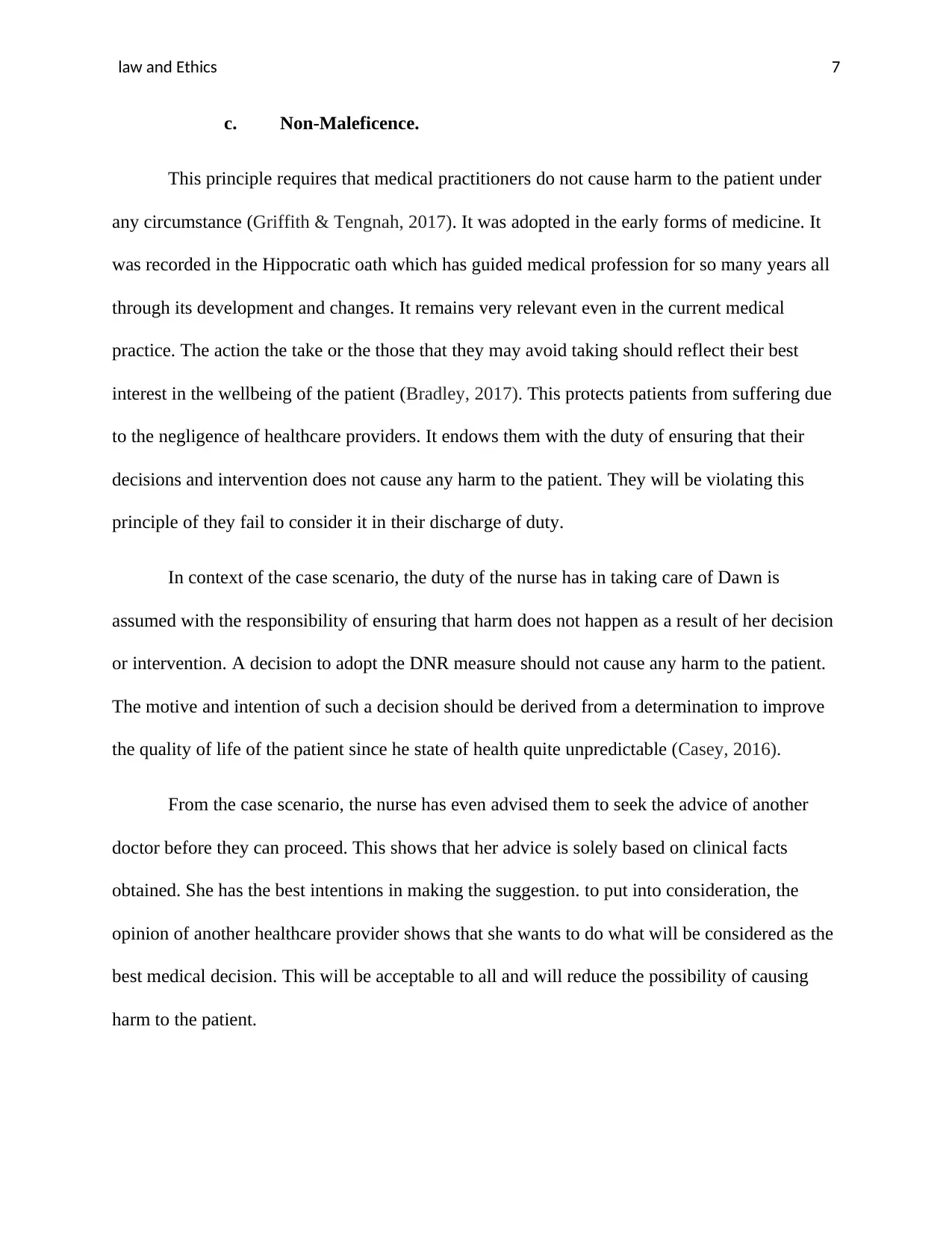
law and Ethics 7
c. Non-Maleficence.
This principle requires that medical practitioners do not cause harm to the patient under
any circumstance (Griffith & Tengnah, 2017). It was adopted in the early forms of medicine. It
was recorded in the Hippocratic oath which has guided medical profession for so many years all
through its development and changes. It remains very relevant even in the current medical
practice. The action the take or the those that they may avoid taking should reflect their best
interest in the wellbeing of the patient (Bradley, 2017). This protects patients from suffering due
to the negligence of healthcare providers. It endows them with the duty of ensuring that their
decisions and intervention does not cause any harm to the patient. They will be violating this
principle of they fail to consider it in their discharge of duty.
In context of the case scenario, the duty of the nurse has in taking care of Dawn is
assumed with the responsibility of ensuring that harm does not happen as a result of her decision
or intervention. A decision to adopt the DNR measure should not cause any harm to the patient.
The motive and intention of such a decision should be derived from a determination to improve
the quality of life of the patient since he state of health quite unpredictable (Casey, 2016).
From the case scenario, the nurse has even advised them to seek the advice of another
doctor before they can proceed. This shows that her advice is solely based on clinical facts
obtained. She has the best intentions in making the suggestion. to put into consideration, the
opinion of another healthcare provider shows that she wants to do what will be considered as the
best medical decision. This will be acceptable to all and will reduce the possibility of causing
harm to the patient.
c. Non-Maleficence.
This principle requires that medical practitioners do not cause harm to the patient under
any circumstance (Griffith & Tengnah, 2017). It was adopted in the early forms of medicine. It
was recorded in the Hippocratic oath which has guided medical profession for so many years all
through its development and changes. It remains very relevant even in the current medical
practice. The action the take or the those that they may avoid taking should reflect their best
interest in the wellbeing of the patient (Bradley, 2017). This protects patients from suffering due
to the negligence of healthcare providers. It endows them with the duty of ensuring that their
decisions and intervention does not cause any harm to the patient. They will be violating this
principle of they fail to consider it in their discharge of duty.
In context of the case scenario, the duty of the nurse has in taking care of Dawn is
assumed with the responsibility of ensuring that harm does not happen as a result of her decision
or intervention. A decision to adopt the DNR measure should not cause any harm to the patient.
The motive and intention of such a decision should be derived from a determination to improve
the quality of life of the patient since he state of health quite unpredictable (Casey, 2016).
From the case scenario, the nurse has even advised them to seek the advice of another
doctor before they can proceed. This shows that her advice is solely based on clinical facts
obtained. She has the best intentions in making the suggestion. to put into consideration, the
opinion of another healthcare provider shows that she wants to do what will be considered as the
best medical decision. This will be acceptable to all and will reduce the possibility of causing
harm to the patient.
Paraphrase This Document
Need a fresh take? Get an instant paraphrase of this document with our AI Paraphraser
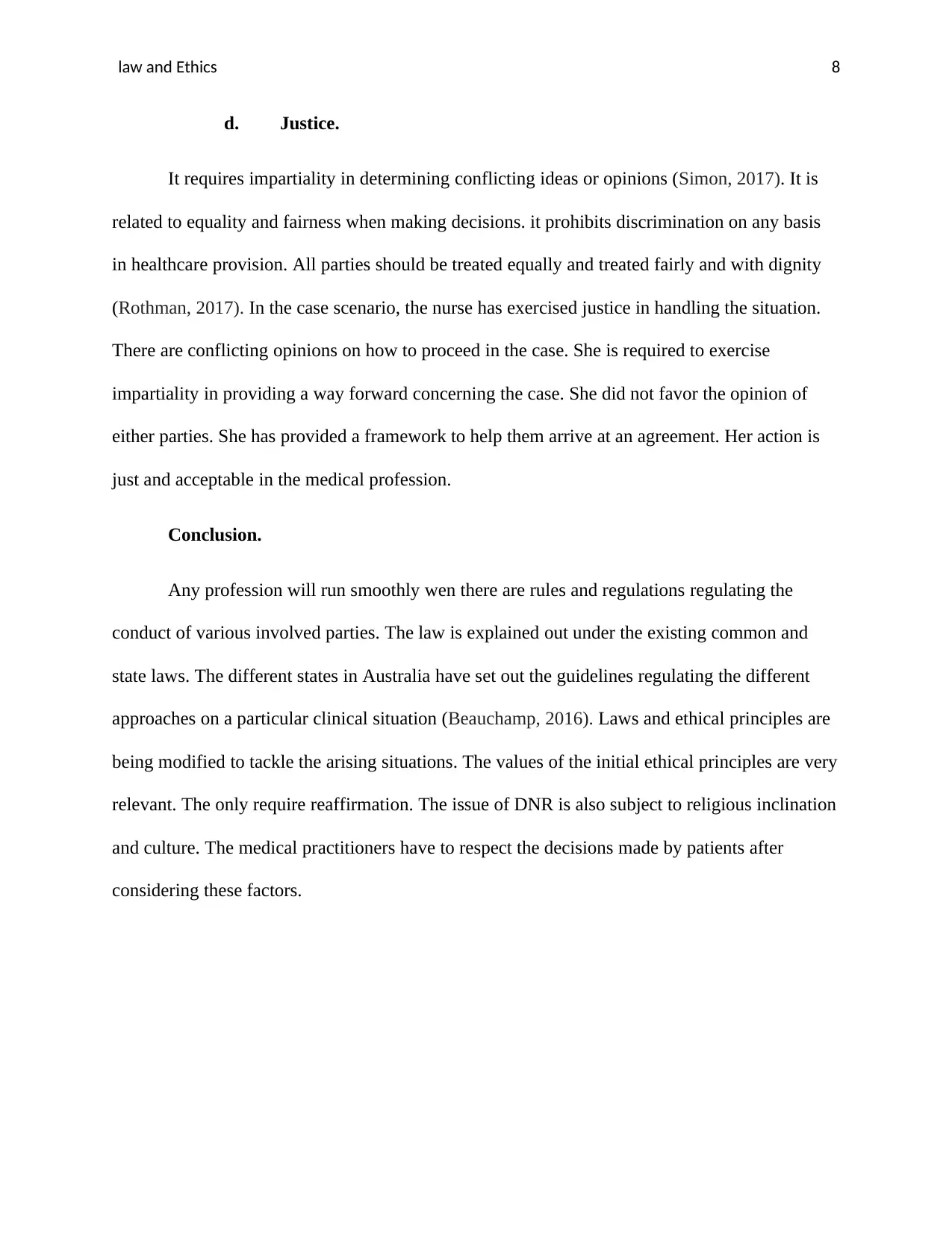
law and Ethics 8
d. Justice.
It requires impartiality in determining conflicting ideas or opinions (Simon, 2017). It is
related to equality and fairness when making decisions. it prohibits discrimination on any basis
in healthcare provision. All parties should be treated equally and treated fairly and with dignity
(Rothman, 2017). In the case scenario, the nurse has exercised justice in handling the situation.
There are conflicting opinions on how to proceed in the case. She is required to exercise
impartiality in providing a way forward concerning the case. She did not favor the opinion of
either parties. She has provided a framework to help them arrive at an agreement. Her action is
just and acceptable in the medical profession.
Conclusion.
Any profession will run smoothly wen there are rules and regulations regulating the
conduct of various involved parties. The law is explained out under the existing common and
state laws. The different states in Australia have set out the guidelines regulating the different
approaches on a particular clinical situation (Beauchamp, 2016). Laws and ethical principles are
being modified to tackle the arising situations. The values of the initial ethical principles are very
relevant. The only require reaffirmation. The issue of DNR is also subject to religious inclination
and culture. The medical practitioners have to respect the decisions made by patients after
considering these factors.
d. Justice.
It requires impartiality in determining conflicting ideas or opinions (Simon, 2017). It is
related to equality and fairness when making decisions. it prohibits discrimination on any basis
in healthcare provision. All parties should be treated equally and treated fairly and with dignity
(Rothman, 2017). In the case scenario, the nurse has exercised justice in handling the situation.
There are conflicting opinions on how to proceed in the case. She is required to exercise
impartiality in providing a way forward concerning the case. She did not favor the opinion of
either parties. She has provided a framework to help them arrive at an agreement. Her action is
just and acceptable in the medical profession.
Conclusion.
Any profession will run smoothly wen there are rules and regulations regulating the
conduct of various involved parties. The law is explained out under the existing common and
state laws. The different states in Australia have set out the guidelines regulating the different
approaches on a particular clinical situation (Beauchamp, 2016). Laws and ethical principles are
being modified to tackle the arising situations. The values of the initial ethical principles are very
relevant. The only require reaffirmation. The issue of DNR is also subject to religious inclination
and culture. The medical practitioners have to respect the decisions made by patients after
considering these factors.
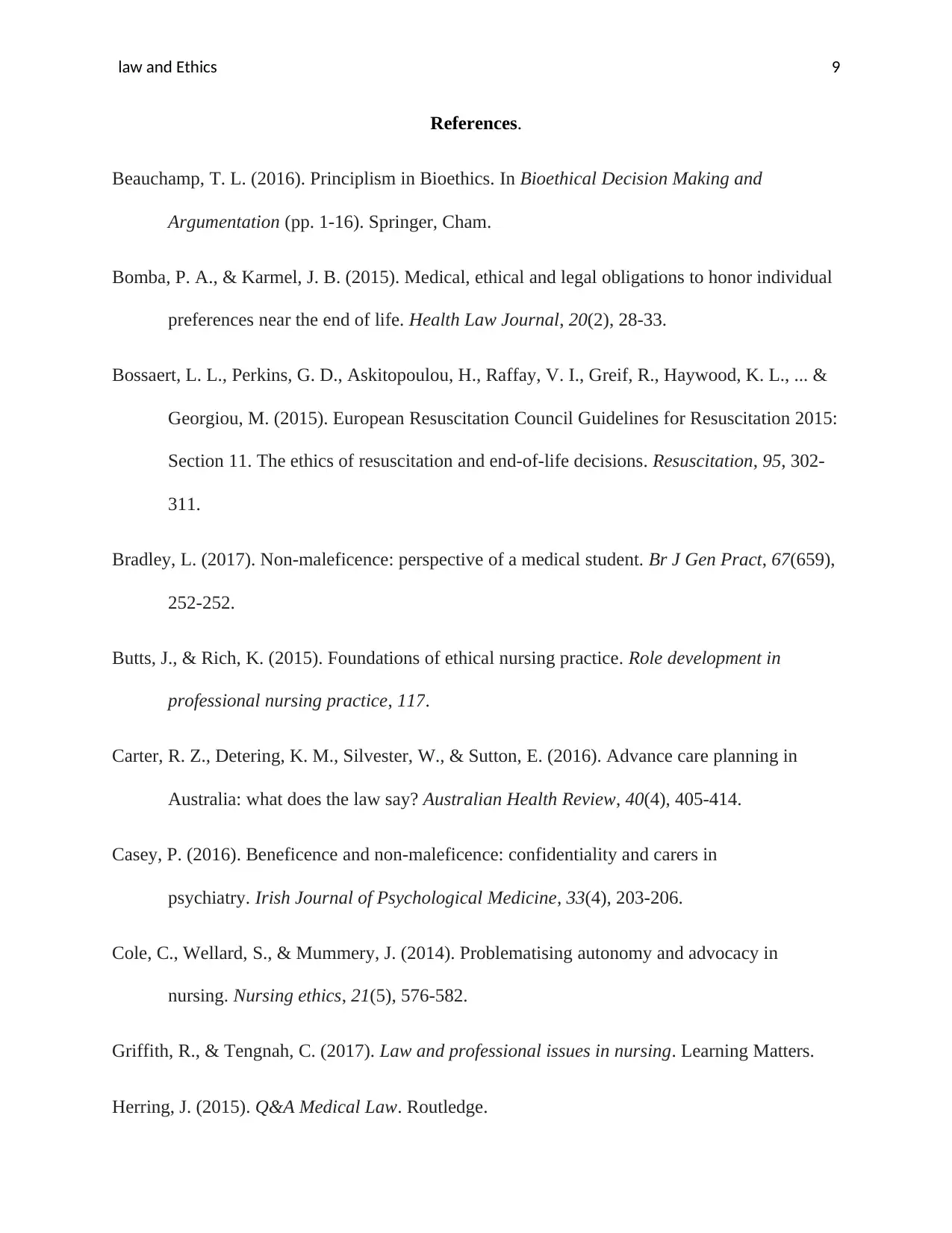
law and Ethics 9
References.
Beauchamp, T. L. (2016). Principlism in Bioethics. In Bioethical Decision Making and
Argumentation (pp. 1-16). Springer, Cham.
Bomba, P. A., & Karmel, J. B. (2015). Medical, ethical and legal obligations to honor individual
preferences near the end of life. Health Law Journal, 20(2), 28-33.
Bossaert, L. L., Perkins, G. D., Askitopoulou, H., Raffay, V. I., Greif, R., Haywood, K. L., ... &
Georgiou, M. (2015). European Resuscitation Council Guidelines for Resuscitation 2015:
Section 11. The ethics of resuscitation and end-of-life decisions. Resuscitation, 95, 302-
311.
Bradley, L. (2017). Non-maleficence: perspective of a medical student. Br J Gen Pract, 67(659),
252-252.
Butts, J., & Rich, K. (2015). Foundations of ethical nursing practice. Role development in
professional nursing practice, 117.
Carter, R. Z., Detering, K. M., Silvester, W., & Sutton, E. (2016). Advance care planning in
Australia: what does the law say? Australian Health Review, 40(4), 405-414.
Casey, P. (2016). Beneficence and non-maleficence: confidentiality and carers in
psychiatry. Irish Journal of Psychological Medicine, 33(4), 203-206.
Cole, C., Wellard, S., & Mummery, J. (2014). Problematising autonomy and advocacy in
nursing. Nursing ethics, 21(5), 576-582.
Griffith, R., & Tengnah, C. (2017). Law and professional issues in nursing. Learning Matters.
Herring, J. (2015). Q&A Medical Law. Routledge.
References.
Beauchamp, T. L. (2016). Principlism in Bioethics. In Bioethical Decision Making and
Argumentation (pp. 1-16). Springer, Cham.
Bomba, P. A., & Karmel, J. B. (2015). Medical, ethical and legal obligations to honor individual
preferences near the end of life. Health Law Journal, 20(2), 28-33.
Bossaert, L. L., Perkins, G. D., Askitopoulou, H., Raffay, V. I., Greif, R., Haywood, K. L., ... &
Georgiou, M. (2015). European Resuscitation Council Guidelines for Resuscitation 2015:
Section 11. The ethics of resuscitation and end-of-life decisions. Resuscitation, 95, 302-
311.
Bradley, L. (2017). Non-maleficence: perspective of a medical student. Br J Gen Pract, 67(659),
252-252.
Butts, J., & Rich, K. (2015). Foundations of ethical nursing practice. Role development in
professional nursing practice, 117.
Carter, R. Z., Detering, K. M., Silvester, W., & Sutton, E. (2016). Advance care planning in
Australia: what does the law say? Australian Health Review, 40(4), 405-414.
Casey, P. (2016). Beneficence and non-maleficence: confidentiality and carers in
psychiatry. Irish Journal of Psychological Medicine, 33(4), 203-206.
Cole, C., Wellard, S., & Mummery, J. (2014). Problematising autonomy and advocacy in
nursing. Nursing ethics, 21(5), 576-582.
Griffith, R., & Tengnah, C. (2017). Law and professional issues in nursing. Learning Matters.
Herring, J. (2015). Q&A Medical Law. Routledge.
⊘ This is a preview!⊘
Do you want full access?
Subscribe today to unlock all pages.

Trusted by 1+ million students worldwide
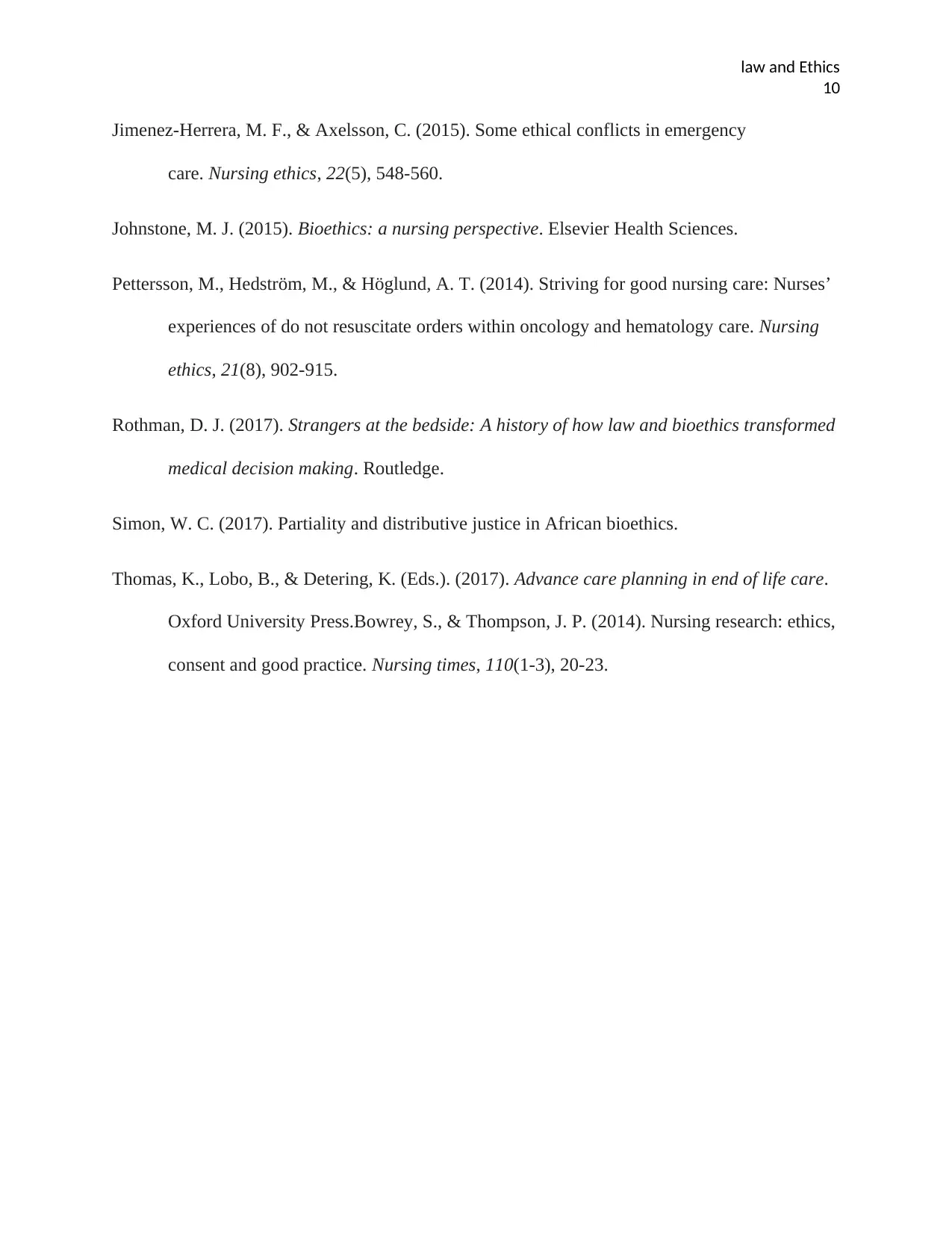
law and Ethics
10
Jimenez-Herrera, M. F., & Axelsson, C. (2015). Some ethical conflicts in emergency
care. Nursing ethics, 22(5), 548-560.
Johnstone, M. J. (2015). Bioethics: a nursing perspective. Elsevier Health Sciences.
Pettersson, M., Hedström, M., & Höglund, A. T. (2014). Striving for good nursing care: Nurses’
experiences of do not resuscitate orders within oncology and hematology care. Nursing
ethics, 21(8), 902-915.
Rothman, D. J. (2017). Strangers at the bedside: A history of how law and bioethics transformed
medical decision making. Routledge.
Simon, W. C. (2017). Partiality and distributive justice in African bioethics.
Thomas, K., Lobo, B., & Detering, K. (Eds.). (2017). Advance care planning in end of life care.
Oxford University Press.Bowrey, S., & Thompson, J. P. (2014). Nursing research: ethics,
consent and good practice. Nursing times, 110(1-3), 20-23.
10
Jimenez-Herrera, M. F., & Axelsson, C. (2015). Some ethical conflicts in emergency
care. Nursing ethics, 22(5), 548-560.
Johnstone, M. J. (2015). Bioethics: a nursing perspective. Elsevier Health Sciences.
Pettersson, M., Hedström, M., & Höglund, A. T. (2014). Striving for good nursing care: Nurses’
experiences of do not resuscitate orders within oncology and hematology care. Nursing
ethics, 21(8), 902-915.
Rothman, D. J. (2017). Strangers at the bedside: A history of how law and bioethics transformed
medical decision making. Routledge.
Simon, W. C. (2017). Partiality and distributive justice in African bioethics.
Thomas, K., Lobo, B., & Detering, K. (Eds.). (2017). Advance care planning in end of life care.
Oxford University Press.Bowrey, S., & Thompson, J. P. (2014). Nursing research: ethics,
consent and good practice. Nursing times, 110(1-3), 20-23.
1 out of 10
Related Documents
Your All-in-One AI-Powered Toolkit for Academic Success.
+13062052269
info@desklib.com
Available 24*7 on WhatsApp / Email
![[object Object]](/_next/static/media/star-bottom.7253800d.svg)
Unlock your academic potential
Copyright © 2020–2025 A2Z Services. All Rights Reserved. Developed and managed by ZUCOL.





